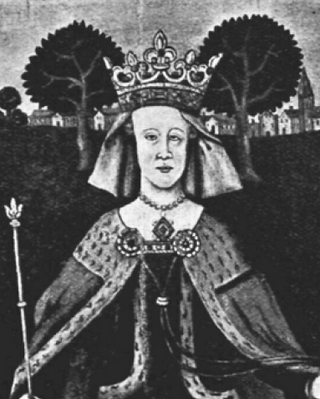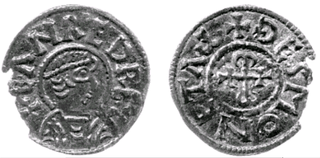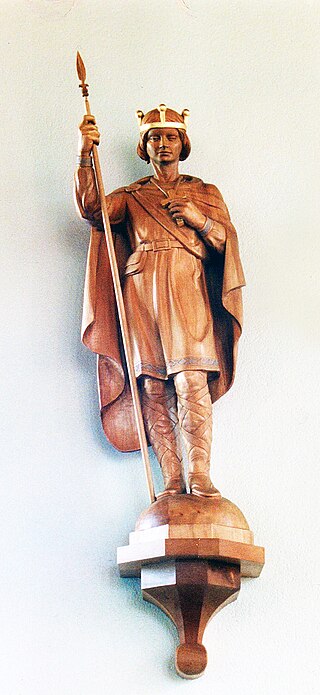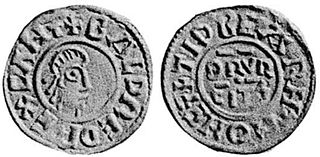Related Research Articles

Eadwig was King of England from 23 November 955 until his death in 959. He was the elder son of Edmund I and his first wife Ælfgifu, who died in 944. Eadwig and his brother Edgar were young children when their father was killed trying to rescue his seneschal from attack by an outlawed thief on 26 May 946. As Edmund's sons were too young to rule he was succeeded by his brother Eadred, who suffered from ill health and died unmarried in his early 30s.

Edward the Martyr was King of the English from 8 July 975 until he was killed in 978. He was the eldest son of King Edgar. On Edgar's death, the succession to the throne was contested between Edward's supporters and those of his younger half-brother, the future King Æthelred the Unready. As they were both children, it is unlikely that they played an active role in the dispute, which was probably between rival family alliances. Edward's principal supporters were Dunstan, Archbishop of Canterbury, and Æthelwine, Ealdorman of East Anglia, while Æthelred was backed by his mother, Queen Ælfthryth and her friend Æthelwold, Bishop of Winchester. The dispute was quickly settled. Edward was chosen as king and Æthelred received the lands traditionally allocated to the king's eldest son in compensation.

Edgar was King of the English from 959 until his death in 975. He became king of all England on his brother's death. He was the younger son of King Edmund I and his first wife Ælfgifu. A detailed account of Edgar's reign is not possible, because only a few events were recorded by chroniclers and monastic writers were more interested in recording the activities of the leaders of the church.

Eadred was King of the English from 26 May 946 until his death in 955. He was the younger son of Edward the Elder and his third wife Eadgifu, and a grandson of Alfred the Great. His elder brother, Edmund, was killed trying to protect his seneschal from an attack by a violent thief. Edmund's two sons, Eadwig and Edgar, were then young children, so Eadred became king. He suffered from ill health in the last years of his life and he died at the age of a little over thirty, having never married. He was succeeded successively by his nephews, Eadwig and Edgar.
Ealhmund was King of Kent in 784. He was probably the father of King Ecgberht who was King of Wessex from 802, and who conquered Kent in the 820s. Ecgberht was the grandfather of King Alfred the Great.

Eadgifu of Kent was the third wife of Edward the Elder, King of Wessex.

Eanred was king of Northumbria in the early ninth century.

Saint Kenelm was an Anglo-Saxon saint, venerated throughout medieval England, and mentioned in the Canterbury Tales. William of Malmesbury, writing in the 12th century, recounted that "there was no place in England to which more pilgrims travelled than to Winchcombe on Kenelm's feast day".
Aldhun of Durham, also known as Ealdhun, was the last Bishop of Lindisfarne and the first Bishop of Durham. He was of "noble descent".
Æthelgar was Archbishop of Canterbury, and previously Bishop of Selsey.
Eanbald I was an eighth century Archbishop of York.

Wulfred was an Anglo-Saxon Archbishop of Canterbury in medieval England. Nothing is known of his life prior to 803, when he attended a church council, but he was probably a nobleman from Middlesex. He was elected archbishop in 805 and spent his time in office reforming the clergy of his cathedral. He also quarrelled with two consecutive Mercian kings – Coenwulf and Ceolwulf – over whether laymen or clergy should control monasteries. At one point, Wulfred travelled to Rome to consult with the papacy and was deposed from office for a number of years over the issue. After Coenwulf's death, relations were somewhat better with the new king Ceolwulf, but improved much more after Ceolwulf's subsequent deposition. The dispute about control of the monasteries was not fully settled until 838, after Wulfred's death. Wulfred was the first archbishop to place his portrait on the coinage he struck.
Feologild was a medieval English clergyman. He was probably elected Archbishop of Canterbury, although controversy surrounds his election. Some modern historians argue that instead of being elected, he was merely an unsuccessful candidate for the office. He died soon after his consecration, if indeed he was consecrated.

Baldred was king of Kent, from 823 until 826 or 827. Ceolwulf I, king of Mercia, had ruled Kent directly, and was deposed by Beornwulf in 823, and at about the same time moneyers at Canterbury started issuing coins in the name of Baldred, king of Kent. It is uncertain whether he was independent or a Mercian under-king. In 826 or 827 he was expelled by Æthelwulf, son of King Egbert of Wessex, and Kent was ruled directly by Wessex thereafter.

Saint Mildrith, also Mildthryth, Mildryth and Mildred,, was a 7th- and 8th-century Anglo-Saxon abbess of the Abbey at Minster-in-Thanet, Kent. She was declared a saint after her death, and, in 1030, her remains were moved to Canterbury.
Ælfflæd or Æthelflæd is not recorded before the twelfth century. William of Malmesbury describes Æthelflæd as the daughter of King Ceolwulf I of Mercia, wife of King Wiglaf's son Wigmund, and mother of Wigstan.
Ealdgyth, also Aldgyth or Edith in modern English, was a daughter of Ælfgar, Earl of Mercia, the wife of Gruffudd ap Llywelyn, ruler of all Wales, and later the wife and queen consort of Harold Godwinson, king of England in 1066. She was described by William of Jumièges as a considerable beauty.

Domne Eafe, also Domneva, Domne Éue, Æbbe, Ebba, was, according to the Kentish royal legend, a granddaughter of King Eadbald of Kent and the foundress of the double monastery of Minster in Thanet Priory at Minster-in-Thanet during the reign of her cousin King Ecgberht of Kent. A 1000-year-old confusion with her sister Eormenburg means she is often now known by that name. Married to Merewalh of Mercia, she had at least four children. When her two brothers, Æthelred and Æthelberht, were murdered she obtained the land in Thanet to build an abbey, from a repentant King Ecgberht. Her three daughters all went on to become abbesses and saints, the most famous of which, Mildrith, ended up with a shrine in St Augustine's Abbey, Canterbury.

St Mary's Church, Reculver, was founded in the 7th century as either a minster or a monastery on the site of a Roman fort at Reculver, which was then at the north-eastern extremity of Kent in south-eastern England. In 669, the site of the fort was given for this purpose by King Ecgberht of Kent to a priest named Bassa, beginning a connection with Kentish kings that led to King Eadberht II of Kent being buried there in the 760s, and the church becoming very wealthy by the beginning of the 9th century. From the early 9th century to the 11th the church was treated as essentially a piece of property, with control passing between kings of Mercia, Wessex and England and the archbishops of Canterbury. Viking attacks may have extinguished the church's religious community in the 9th century, although an early 11th-century record indicates that the church was then in the hands of a dean accompanied by monks. By the time of Domesday Book, completed in 1086, St Mary's was serving as a parish church.
Ealhhere was ealdorman of Kent. In 850, Æthelwulf, King of Wessex, granted Ealhhere a large estate of forty hides at Lenham in Kent. The following year, he and Æthelstan, the eldest son of King Æthelwulf, defeated an invading Vikings fleet in a naval battle off Sandwich in Kent. Nine ships were captured and the remainder fled. Ealhhere was killed in another battle in 853. According to the Anglo-Saxon Chronicle, "Ealhhere with the inhibitants of Kent, and Huda with the Surrey men, fought in Thanet against a heathen raiding-army; and many were killed and drowned there, and the ealdormen both dead".
References
- 1 2 Kelly 2004.
- ↑ "Charter S 147". The Electronic Sawyer: Online Catalogue of Anglo-Saxon Charters. London, UK: King's College London.
- ↑ Rollason 2004.